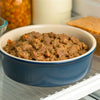Is Wet Dog Food Better Than Dry Dog Food? A Comprehensive Guide for Pet Owners
- Houndsy
Table of Contents
- Introduction
- Understanding Dog Food Basics: What Makes Them Different?
- Benefits of Wet Dog Food
- Drawbacks of Wet Dog Food
- Benefits of Dry Dog Food
- Drawbacks of Dry Dog Food
- Health Considerations for Specific Dogs
- Mixing Wet and Dry Dog Food: The Best of Both Worlds
- Conclusion
Introduction
Imagine your furry friend staring at their food bowl, waiting eagerly for their next meal. Now, picture the wide array of dog food options that flood the market today—kibble, canned wet food, and even semi-moist formulas. With so many choices available, many of us wonder: Is wet dog food better than dry dog food? This question can leave pet owners feeling overwhelmed, especially since our pets are family, and their well-being is our top priority.
Did you know that an estimated 80% of dogs can develop dental disease by the age of three? This statistic highlights just one factor to consider when choosing a diet for your pooch. Our goal with this blog post is to explore the differences, benefits, and drawbacks of both wet and dry dog food, while guiding you toward a well-informed decision that suits your dog’s dietary needs.
By the end of this article, we will have covered the following aspects of wet and dry dog food:
- The nutritional differences between both types
- The various advantages and disadvantages
- Specific health considerations for different dog breeds and life stages
- Tips for mixing and transitioning between wet and dry food
- Our recommendations on how to create a balanced diet for your furry companion
So, let’s dig into this topic together!
Understanding Dog Food Basics: What Makes Them Different?
Before we can definitively answer the question of whether wet dog food is better than dry dog food, we need to understand the nuances that set them apart.
Nutritional Content
Both wet and dry dog foods are formulated to provide essential nutrients. However, their composition can vary significantly. Wet dog food typically contains:
- Higher moisture content: Generally between 70-80%, which can aid in hydration.
- Higher protein levels: This often makes wet food more palatable and appealing to dogs.
- Less carbohydrate content: Resulting in lower caloric density when compared to dry dog food.
On the other hand, dry dog food (or kibble) has:
- Lower moisture content: Ranging from 8-12%, which means it offers a denser calorie count.
- Higher carbohydrate content: This often serves as a binding ingredient in kibble production.
- Longer shelf life: Dry food can remain fresh for weeks when stored in a sealed bag.
The Processing Difference
The method of processing dog food not only affects the texture but also its nutrient absorption rate:
- Wet Dog Food: Usually involves cooking proteins, combining them with grains and other nutrients, then sealing them in cans or pouches. As a result, wet food can sometimes be higher in preservatives compared to dry food.
- Dry Dog Food: Formulated through a process known as extrusion. The ingredients are cooked and then shaped into kibble. This method tends to lead to the incorporation of better preservatives.
Brand Choices Matter
Regardless of being either wet or dry, the quality and reputation of the brand you choose can affect your dog’s health just as much as the type of food. At Houndsy, we prioritize using high-quality ingredients in any product we recommend, ensuring that your furry friend enjoys a nutritious meal that supports their health and well-being.
Benefits of Wet Dog Food
Let’s dive deeper into the advantages that wet dog food may present over its dry counterpart.
1. Enhanced Palatability
Wet dog food is often more aromatic and flavorful, appealing to even the pickiest eaters. This can be especially beneficial for:
- Dogs recovering from illness: They may find the taste and smell of wet food more enticing during the recovery process.
- Senior dogs: With decreased sense of smell, they might prefer the stronger flavors of wet food.
2. Increased Hydration
One of the standout features of wet dog food is its high moisture content, which can significantly aid in hydration. This becomes particularly important for:
- Dogs that are less inclined to drink water, helping to prevent urinary tract problems.
- Older dogs who may be at risk for dehydration, or those with kidney issues.
3. Easier to Chew
For dogs with dental issues or missing teeth, wet food is simply easier to manage. Smaller breeds and older dogs can particularly benefit from this texture.
4. Weight Management
Due to their moisture content, wet foods can create a feeling of satiety without adding as many calories as dry food, making them a good choice for pets that need to lose weight.
5. Convenient for Mixing Medications
If your dog requires medication, wet food can be a perfect way to hide pills or make the medication easier for them to consume.
Drawbacks of Wet Dog Food
Despite its many benefits, wet dog food does have some drawbacks to consider:
1. Shorter Shelf Life
Once opened, wet food must be consumed quickly—typically within a few days—otherwise, it can spoil. This can lead to food waste if you have a finicky eater.
2. Higher Cost
Wet dog food is generally more expensive on a per-calorie basis compared to dry food. For families with larger dogs or multiple pets, this can add up quickly.
3. Messier Feeding
If your dog is a messy eater, wet food may lead to clean-up challenges, with splattered food or residue stuck in your dog's fur.
4. Lack of Dental Health Benefits
Unlike dry food, which can assist in scraping away plaque as dogs chew, wet food doesn’t provide the same dental benefits.
Benefits of Dry Dog Food
Now let’s explore the advantages that dry dog food has to offer.
1. Dental Health Benefits
The crunchiness of kibble can help to reduce plaque and tartar buildup on dogs’ teeth—an important factor for canine dental health.
2. Convenience and Portion Control
Dry food is easier to portion out, store, and measure when managing a dog’s daily intake. It’s also less likely to spoil if left out throughout the day, making it suitable for dogs that like to graze.
3. Cost-Effectiveness
Dry food typically offers a better value when you consider the price per calorie, making it a budget-friendly option for pet owners.
4. Less Mess
Kibble is cleaner and less odorous than wet food, which can make mealtimes more pleasant for pet owners.
Drawbacks of Dry Dog Food
However, dry food may not be suitable for every dog, and it does come with its challenges:
1. Hydration Concern
Given the low moisture content, dry dog food does not support hydration well. For dogs that do not drink sufficient water, this could lead to dehydration.
2. Less Appealing to Picky Eaters
If your dog is particularly fussy, they may find dry food less exciting and appetizing compared to the rich flavors of wet dog food.
3. Not Ideal for Sensitive Teeth
For dogs with dental issues or sensitivities, dry food can be harder to chew and digest.
Health Considerations for Specific Dogs
While considering the pros and cons between wet and dry dog food, it’s essential to keep the individual needs of your dog in mind.
For Puppies
Young dogs, particularly those still transitioning from their mother’s milk to solid food, often thrive on the soft texture of wet food. However, as they mature, many pet owners begin transitioning them to dry food for the benefits it provides.
For Senior Dogs
Senior dogs may benefit from the moisture and softer consistency of wet food. It can also help with hydration, which is particularly beneficial for those with kidney problems.
For Dogs with Health Concerns
- Dogs with dental issues may require wet food for easier consumption.
- Dogs prone to urinary or kidney disease may benefit from the added moisture found in wet food.
- Dogs that need to manage their weight might do well with a balanced approach, mixing both wet and dry options.
Mixing Wet and Dry Dog Food: The Best of Both Worlds
For many pet owners, the ultimate solution might be a combination of both wet and dry food. Mixing can provide a well-rounded diet that caters to your dog's preferences and health needs. Here’s how to do it effectively:
- Portion Control: Consult with your veterinarian to determine the appropriate daily calorie requirements and calculate how to distribute between wet and dry options.
- Gradual Transition: When introducing a new food, do so gradually over 5-7 days to prevent digestive upset.
- Monitor Weight: Keep an eye on your dog’s weight and adjust portion sizes as necessary.
Conclusion
Ultimately, the decision between wet dog food and dry dog food comes down to your pet’s individual needs, preferences, and your lifestyle as a pet owner. Each type offers unique benefits and drawbacks that can impact your dog’s health and feeding experience. At Houndsy, our flagship product, the Houndsy Kibble Dispenser, is designed to help make feeding time a delightful experience by offering the perfect portions in a beautifully designed package.
Explore how our innovative design can simplify your dog's feeding routine while ensuring they receive the best nourishment possible—order the Houndsy Kibble Dispenser today!
FAQ
1. Can I feed my dog both wet and dry food? Yes! Many pet owners choose to combine the two to take advantage of the benefits each offers. Just make sure to monitor portion sizes to avoid overfeeding.
2. Which is better for dogs with kidney issues? Wet food is often favored for dogs with kidney issues due to its high moisture content, which can help in maintaining hydration.
3. Is there a specific age when I should switch from wet to dry food? Puppies often start on wet food or softened kibble to assist with their transition from milk. As they age, you can steadily introduce dry food based on their health and preferences.
4. How can I encourage my dog to eat if they are picky? Consider offering a mix of wet food toppered on dry kibble to enhance palatability. Heating wet food can also make it more appealing by releasing aromatic scents.
5. How do I choose the right brand of dog food? Select high-quality brands with clear ingredient labeling. It is also a good idea to consult your veterinarian for personalized recommendations based on your dog’s specific health needs.












